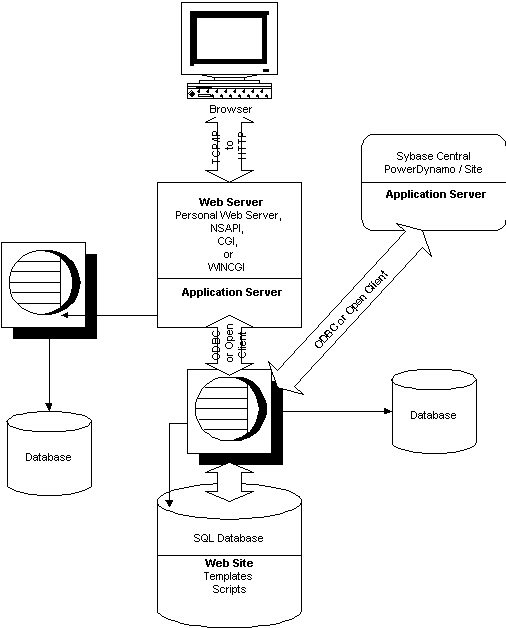

Chapter 4 Configuring Web Servers and Web sites
If you have a live Internet connection you do not need to use the Personal Web Server to access Dynamo Web content on a Web site. In this case, you use one of the application servers (or gateways) provided as part of PowerDynamo to serve Dynamo Web site content to the site Web server.

PowerDynamo includes an Application Server for each of these interfaces:
If you have a Web server installed on your machine, the installation program allows you to configure the server to work with PowerDynamo. The installation program will add the appropriate DLLs to your system path, and install the PowerDynamo Application Server software on the Web server machine. This eliminates the need for steps 1 and 2 listed below. You must still complete steps 3 through 5 for PowerDynamo to work properly.
If you install a Web server after installing
PowerDynamo, you can use the setup -webserver
command
to reexecute the installation program.
The following procedure is an overview of the steps required to configure a Dynamo Web site. Detailed instructions specific to each of the supported server interfaces follow.
![]() Ensure that PowerDynamo has been installed
on the Web server machine before beginning configuration. For future
administration use, it is recommended that all PowerDynamo components
remain installed on the Web server machine. You must confirm that
you are properly licensed to use PowerDynamo and Adaptive Server
Anywhere or Adaptive Server Enterprise on your Web site before configuring
your Web site.
Ensure that PowerDynamo has been installed
on the Web server machine before beginning configuration. For future
administration use, it is recommended that all PowerDynamo components
remain installed on the Web server machine. You must confirm that
you are properly licensed to use PowerDynamo and Adaptive Server
Anywhere or Adaptive Server Enterprise on your Web site before configuring
your Web site.
![]() To configure a Dynamo Web site:
To configure a Dynamo Web site:
![]()
Important
The above steps rely on tools available
from PowerDynamo.
| Copyright © 1999 Sybase, Inc. All rights reserved. |

| |